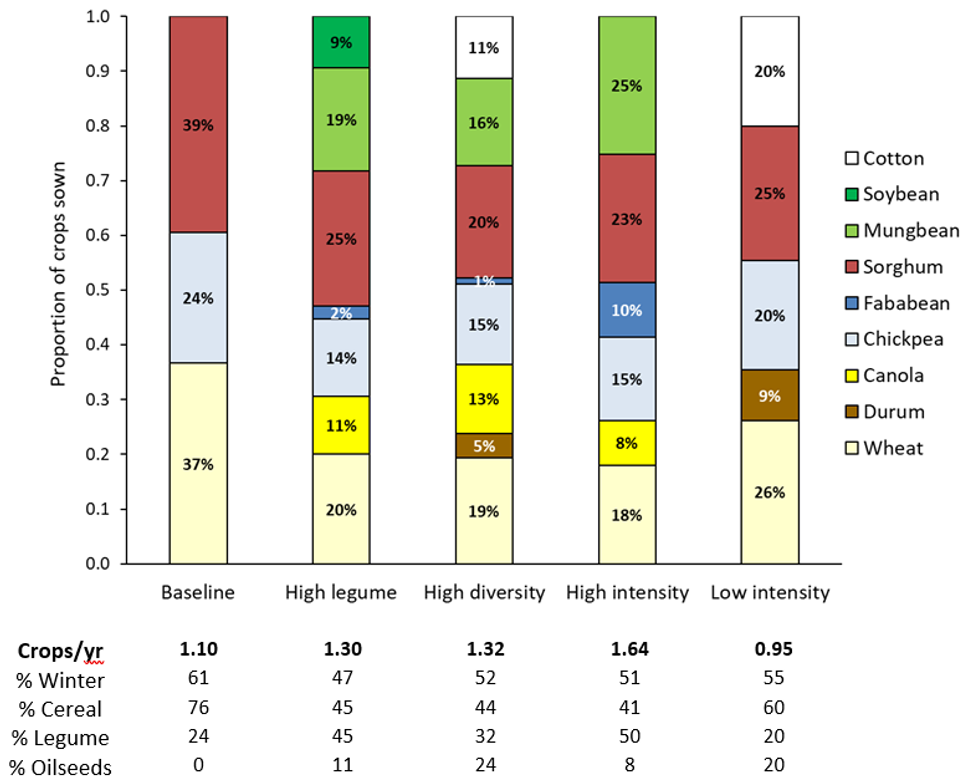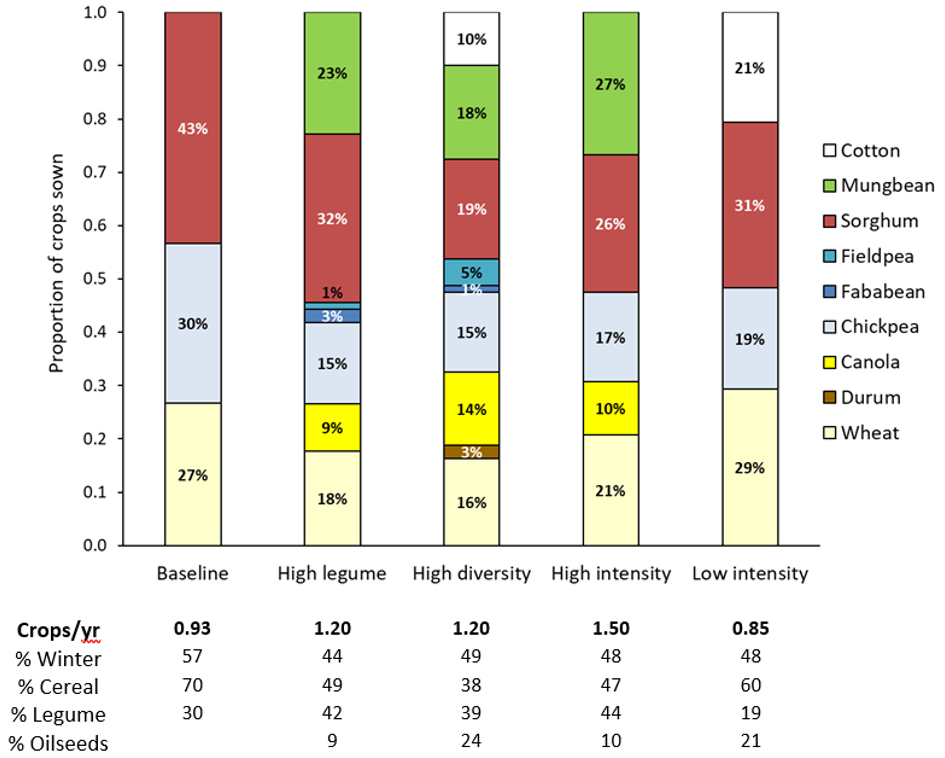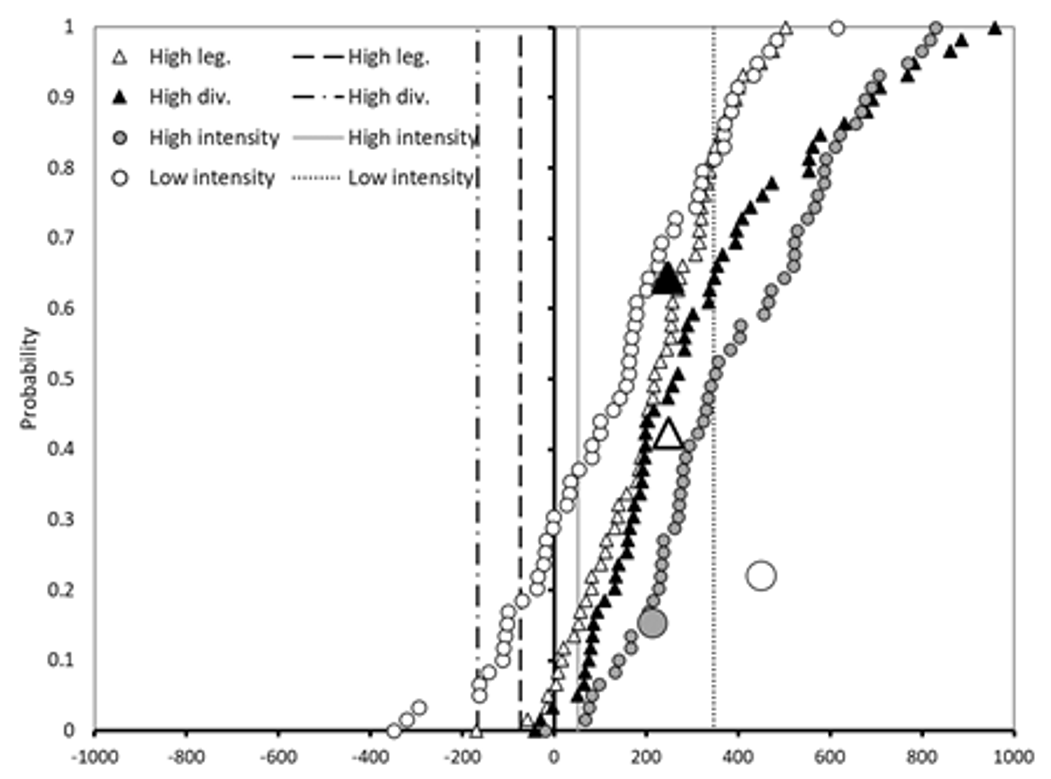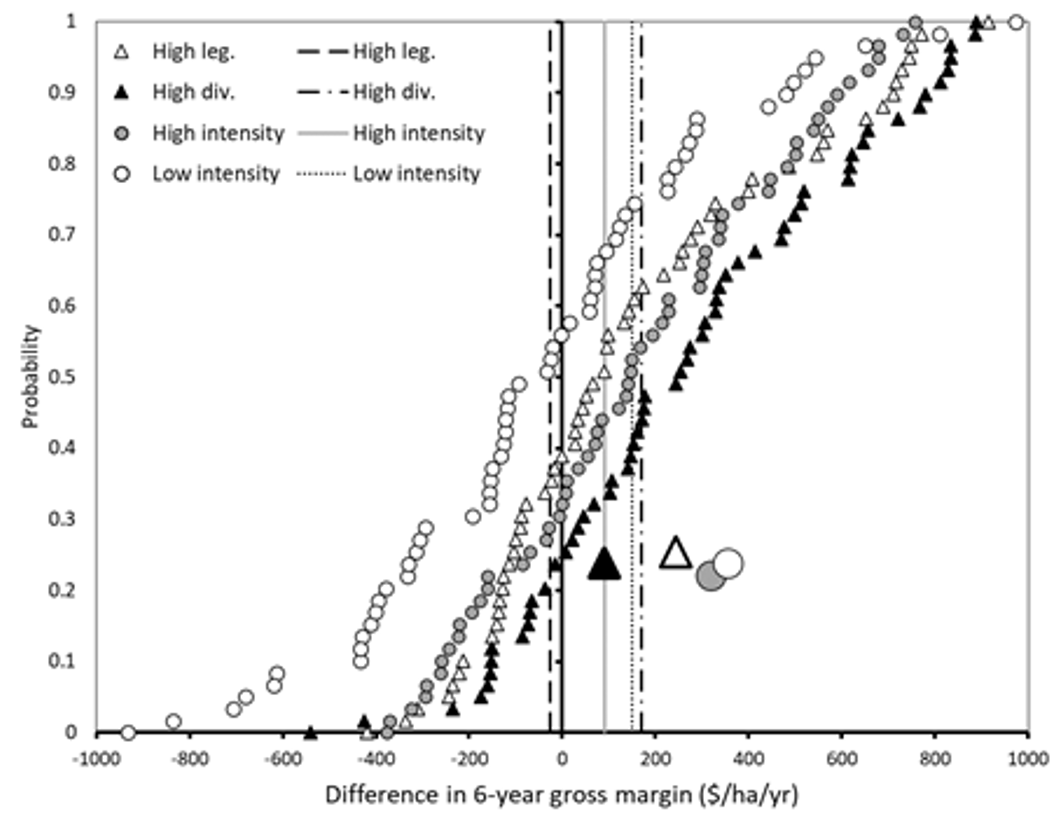Short and long-term profitability of different farming systems - northern NSW
Short and long-term profitability of different farming systems - northern NSW
Author: Lindsay Bell (CSIRO), Jeremy Whish (CSIRO), Heidi Horan (CSIRO) | Date: 02 Mar 2023
Take home message
- Farming system decisions – crop choice and soil water required for sowing can have a large influence on system profitability over the short and long-term; differences of >$100/ha/yr occur regularly
- Systems involving alternative crop types can not only help manage biotic threats (e.g. diseases and weeds) but also be profitable compared with conventional systems
- While the last 7 years have presented a diverse range of seasons, this period ranks in the lowest 15% of seasons in terms of potential profit of the farming system
- Simulated predictions of relative profitability of the systems generally correspond well with those calculated from experimental data over the same period.
Introduction
The northern farming systems project has been examining how different farming system strategies impact on various aspects of the farming system since 2015. Across a diverse range of production environments, we have tested the impacts of changing:
- The mix of crops grown by increasing the frequency of legumes or diversifying crop choices to provide disease breaks, or
- The intensity of the cropping system by either increasing it by reducing the soil water threshold to sow more crops or by reducing it and only growing higher profit crops once the soil profile is full; and
- The supply of nutrients provided to crops.
Despite now collecting over 6 years of data on each of these different farming strategies, the full range of climatic conditions that are experienced across the region have not been captured. In particular, most sites have experienced extremely dry periods over the past 6 years, which is likely to bias or favour some particular farming systems. Simulation modelling can be useful to help explore how the different farming strategies might perform over the longer-term and under a range of climatic conditions. In this paper we compare APSIM predictions of system profitability over the long term with those for the period 2016-2021. This paper reports specifically on results from the two sites in northern NSW at Narrabri and Spring Ridge (Liverpool Plains).
System simulations and estimates of profitability
The different farming systems were simulated from 1957 to 2021 using APSIM. Soils used in simulations were those characterised at each location, and long-term climate data was sourced from the closest meteorological station. For each farming system at each location, the simulation was provided a list of crops (prioritised), their sowing window, and minimum soil water required to allow them to be sown. An example of the rules dictating crop choices at the Pampas site are outlined in Table 1; other sites vary in the crop choices, their sowing dates and soil water thresholds but the general rules dictating crop choice were constant.
Revenue, costs and gross margin for each crop were calculated using predicted grain yields and estimates of crop protection, non-N fertilisers and operational costs for each crop (see Table 2). Fertiliser inputs were simulated dynamically based on a crop budget targeting a median yield (N fertiliser was costed at $1.30/kg N), and fallow herbicide applications ($15/ha/spray) were also predicted using the model based on the number of germination events that occurred.
Table 1. Rules associated with crop choice, crops available and their plant-available water threshold required to be sown in the Baseline and 3 modified farming systems at Narrabri and Spring Ridge sites.
*Indicates that this crop was not available as an option in this system at this site.
System | Crop choice rules | Crops | Soil water threshold (mm PAW) | |
|---|---|---|---|---|
Narrabri | Spring Ridge | |||
Baseline | No more than 3 winter cereals or sorghum in a row ≥2 yrs between chickpea | Wheat Chickpea Sorghum | 110 100 120 | 110 100 120 |
High legume | As above + Legume every second crop | As above + Fababean Mungbean Soybean Fieldpea Canola | 120 110 120 * * | 120 110 * 110 120 |
Higher crop | As in Baseline + ≥1 yr break after any crop ≥50% crops nematode resistant | As above + Canola Durum Fieldpea Cotton | 120 110 110 120 | 120 110 110 120 |
Higher crop | As in baseline | Wheat Chickpea Barley Sorghum Mungbean Fababean Canola | 70 50 70 90 50 100 100 | 70 50 70 90 50 * 100 |
Lower crop | As in baseline | Wheat Chickpea Sorghum Durum Cotton | 180 180 180 180 180 | 180 180 180 * 180 |
Table 2. Assumed prices (10-year average, farm gate after grading/bagging/drying) and variable costs for inputs and operations (e.g., seed, pesticides, starter fertilisers, sowing, spraying) and harvest costs (for viable yields only) for each crop simulated.
Crop | Price ($/t product) | Variable crop Costs ($/ha) | Harvest costs ($/ha) |
|---|---|---|---|
Wheat | 269 | 175 | 40 |
Durum | 335 | 175 | 40 |
Barley | 218 | 175 | 40 |
Chickpea | 504 | 284 | 45 |
Sorghum | 221 | 221 | 55 |
Mungbean | 667 | 276 | 55 |
Fababean | 382 | 341 | 40 |
Field pea | 382 | 341 | 40 |
Canola | 503 | 351 | 70 |
Soybean | 607 | 305 | 55 |
Maize | 250 | 218 | 55 |
Cotton | 1800A | 774 | 280 |
A – Calculated on total harvest assuming 45% cotton lint turnout and 55% seed.
Because of the dynamic nature and range of different crops across these simulations, we generated only a single crop sequence over the simulated period. To allow analysis of the climate-induced variability, we aggregated the system gross margins over sequential 6-year; for example, from 1957-1962, 1958-1963 and so on. Hence, we were able to compare what the simulations predicted would occur during the experimental period of 2016-2021 compared to 54 other 6-year periods, thus allowing us to examine how this period compared with longer-term conditions. We were also able to compare the relative performance of the different simulated systems over this period compared to their relative performance from our experimental data. Differences in how costs were calculated, with simulations assuming a set crop input cost, meant there was always a difference in the actual gross margins estimated from the model compared to the actual costs attributed in the experiments.
Crop sequences & frequencies amongst simulated systems
The simulation rules imposed (Table 1) resulted in some clear changes in the frequency and types of crops grown in the farming system. Because of the similar compliment of crops available at these two sites very similar trends were observed (Figure 1 and 2).
The Higher legume systems resulted in additional mungbean and soybean (at Narrabri) crops and occasionally fababean replaced chickpea in the crop sequence (Figure 1). The additional summer legumes also saw the crop intensity increase (by 0.2 crops/yr). The Higher crop diversity system saw sorghum replaced by cotton at times and canola or durum wheat replacing some wheat crops. Again, in this system, the addition of mungbean saw the crop intensity also increase compared to the Baseline. The Higher intensity strategy (i.e., lower soil water thresholds to sow crops) saw a further increase in crop frequency by about 0.5 crops/yr, with additional mungbean or fababean/chickpea crops sown as double crops frequently in the system. The Lower intensity system (i.e., a higher soil water threshold to sow crops) saw the crop frequency drop by only 0.15 crops/yr – less than might be expected; cotton replaced some sorghum crops and durum replaced some wheat crops in the system. While the proportion of winter crop dropped from the Baseline system, the winter crop proportion remained around 50% under all the alternative cropping sequences.

Figure 1. Cropping intensity (crops/yr) and the proportion of different crops simulated under different farming system strategies at Narrabri over the long-term.

Figure 2. Cropping intensity (crops/yr) and the proportion of different crops simulated under different farming system strategies at Spring Ridge over the long-term.
Long-term predictions of system profitability
Figure 2 shows the range in average annual gross margin predicted over all the 6-year periods between 1957 and 2021 amongst the 4 different farming systems. These are arranged from the lowest to the highest to show the distribution of these predictions as a result of climate variability (note prices are held constant at 10-year average values).
At both sites, the Higher intensity system (grey circles) frequently exceeds the profit generated in either the Baseline or Low intensity systems, particularly under more favourable conditions. On the other hand, the Low intensity system (white circles) performs relatively well compared to Baseline, particularly at the Narrabri site, but was less profitable by comparison at the Spring Ridge site.
The analysis also shows that the systems that alter the mix of crop (either Higher legume frequency or higher crop diversity) achieve similar potential profits to the other systems in the lower profitability periods, but potentially offer significant upside under more favourable conditions. In particular, the Higher crop diversity system was able to offer a broader range of crop options to make use of seasonal rainfall and hence was better able to make use of additional crop opportunities when they occurred.
The predicted profit achieved in the experimental period (2016-2021) reflects potential profitability in the lowest 15% of occurrences in all systems, and particularly low in the Baseline, High and Low intensity systems (lowest 5% of periods in the historical record). Based on these predictions this indicates that we would expect relatively small differences amongst the systems over this period, and that over other periods much larger differences in profit may have been generated.
Figure 3. Distribution of simulated gross margins (average of 6-years) over 60 years period (1957-2021) of different farming systems strategies at Narrabri (top) and Spring Ridge (bottom). Each dot indicates the outcome of a 6-year period and the lines indicate the predicted GM for the 2016-2021 period.
Short-term (experimental period) relative to the long-term
When the relative returns achieved from the various systems over the same 6-year period are compared to the Baseline system, this shows that the modified farming systems frequently produce higher average returns (Figure 3). At Narrabri, the Higher diversity, Higher legume and Higher intensity systems produced higher returns > 90% of the time, and at Spring Ridge these systems produced higher returns 60-75% of the time. The Lower intensity systems produced higher profits about 60-70% of the time at Narrabri and only 40% of the time at Spring Ridge. The lower intensity systems also had significantly lower profit in some periods.
The modelled differences between the Baseline and the various other systems over the experimental period (i.e. 2016-2021) are indicated by the larger symbols) in Figure 4 and are compared to the experimental data over the same timeframe (indicated by lines). The higher intensity and Higher legume systems were predicted to be about $200-300/ha/yr ahead, the higher diversity system was $100-200/ha/yr ahead of the Baseline, while the Lower Intensity system was predicted to achieve significantly higher gross-margins (about $400/ha/yr) over that period.
These predictions somewhat over-estimate the relative profitability found experimentally amongst the systems over the same period, but the ranking of the systems are fairly similar. Experimentally the relative difference in profit between the Lower Intensity and Higher intensity systems were similar to the model predictions, though experimentally their advantage over the Baseline system was much less. The Higher legume systems have performed less well experimentally compared the Baseline, indicating that perhaps the long-term simulations may overestimate the frequency of their advantage that was predicted. There was good agreement between the model and experimental data for the High diversity system at Spring Ridge, indicating a reasonable advantage of around $200/ha/yr over the Baseline system. However, this was not the case at Narrabri, with a large discrepancy between the model and experimental data; this was mainly due to a poor return from a frosted canola crop in 2016.
Figure 4. Difference in simulated 6-year gross margin between the Baseline and 4 modified farming systems at Narrabri (top) and Spring Ridge (bottom) between 1957 and 2021. Small symbols show the difference in annual returns over the distribution of the 54 different 6-year periods, the large symbols indicate the difference for a simulation of just the period of 2016-2021, and the vertical lines indicate the differences measured in our experiments over this same period. Negative values indicate the alternative system has produced a lower GM than the Baseline, and vice versa.
Conclusions
Farming strategies or systems need to consider resilience and relative performance across the full range of likely climate variability. While our experimental work has captured a range of seasons, the modelling here adds further insight into how the various farming system strategies might perform over the long-term. The modelling predictions of the relative differences over the past 6 years reflect the relative ranks of the systems with our experimental data over the same period. While some of the alternative systems have not proved to be advantageous over this experimental period, the analysis suggests there is potential to make use of a greater diversity of crops and allow additional opportunities for crops when conditions are appropriate which could add significant upside under more favourable growing seasons. Further examination of the influence of price variability and risk on these findings is required to understand how robust different strategies are, and the key factors that might influence this.
Acknowledgements
The research undertaken as part of this project is made possible by the significant contributions of growers through both trial cooperation and the support of the GRDC, the author would like to thank them for their continued support.
We acknowledge the various collaborators involved with collecting the experimental data and farmer collaborators for hosting the farming systems experiments across the region.
Contact details
Lindsay Bell
CSIRO
203 Tor St, Toowoomba, Qld, 4350.
Ph: 0409 881 988
Email: Lindsay.Bell@csiro.au
Date published: March 2023
GRDC Project Code: DAQ2007-004RMX,




